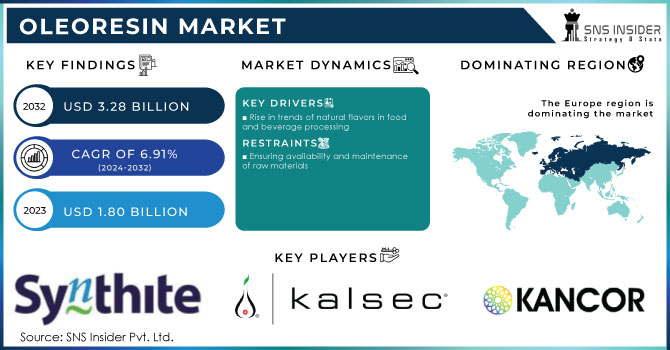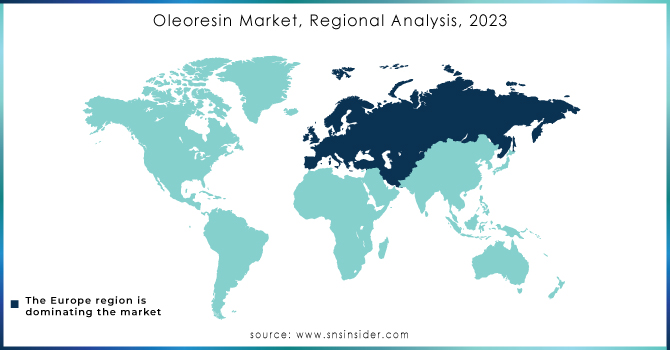Oleoresin Market Report Scope & Overview:

Get More Information on Oleoresin Market - Request Sample Report
The Oleoresin Market size was USD 1.80 billion in 2023 and is expected to Reach USD 3.28 billion by 2032 and grow at a CAGR of 6.91 % over the forecast period of 2024-2032.
The use of oleoresin, with its functional qualities, is extremely important and in high demand in developing countries. Various medical researchers indicate that the use of oleoresin is increasing in the animal feed, pharmaceutical, cosmetic, and food and beverage industries.
Based on product the market is segmented into Paprika, Black Pepper, Turmeric, Ginger, Cinnamon and cassia, Capsicum, and others. The paprika segment is expected to dominate the oleoresin market in 2023, with a revenue share of over 25%. This is due to the increasing demand for paprika oleoresin in the food and beverage industry. Paprika oleoresin is used as a coloring and flavoring agent in a variety of food products, such as sauces, snacks, and dairy products. Also, it is used in pharmaceuticals and cosmetics.
In terms of revenue, the pharmaceuticals application category is anticipated to experience a CAGR of 7.3% over the forecast period. This is a result of oleoresins' numerous health advantages and rising funding for pharmaceutical research and development. These goods are being used by the pharmaceutical industry to create natural treatments for health issues. In contrast to manufactured medications, oleoresins solely offer health advantages when consumed and don't have any negative side effects. Oleoresins' medicinal characteristics are being used by pharmaceutical industry players to diversify their product offerings, which has led to rising demand from the pharmaceutical application market.
MARKET DYNAMICS
KEY DRIVERS
-
Rise in trends of natural flavors in food and beverage processing
Oleoresins are natural extracts that contain essential oils and other flavor compounds. They are used to impart natural flavor and aroma to food and beverages. Consumers are increasingly demanding natural flavors in healthy food and beverage products. They are becoming more aware of the health risks associated with artificial flavors and are looking for alternatives. Oleoresins are a good alternative to artificial flavors because they are made from natural sources and do not have any harmful side effects.
RESTRAIN
-
Ensuring availability and maintenance of raw materials
Oleoresins are derived from spices that are obtained seasonally and their supply is affected by a variety of circumstances, including climate change, pests and illnesses, and political instability. Climate change, such as droughts and floods, can have an impact on the production of black peppercorns, which are grown in tropical and subtropical locations. Black pepper crops can also be harmed by pests and illnesses. Political unrest in some countries may also have an impact on the availability of raw materials for oleoresin production. For example, political unrest in India, a significant producer of ginger, has an impact on the production of ginger oleoresin.
OPPORTUNITY
-
Rising potential health benefits of Oleoresins
-
Increase in demand for feed phytogenics
Feed phytogenics are natural substances used in animal feed to promote livestock health and performance. Oleoresins are an important component of many feed phytogenics, and rising demand for these products is pushing up demand for oleoresins. The increased knowledge of the benefits of natural components in animal feed, as well as the increasing demand for food safety, growing concerns about livestock health, and healthy and high-quality animal products, are driving up demand for feed phytogenics.
CHALLENGES
-
High cost of oleoresins
The cost of oleoresins can be influenced by a variety of factors, including the type of spices and plants used to produce the oleoresin, as some plants and animals are more expensive to grow or maintain than others. Some extraction procedures cost more than others. More concentrated oleoresins are more expensive. When there is a significant demand for oleoresins, the price can be high as well.
IMPACT OF RUSSIA-UKRAINE WAR
Russia and Ukraine are important oleoresin producers, with a combined market share of roughly 25%. The war has impacted production and exports from these countries, resulting in global shortages and higher prices. Export demand for Indian wheat and spices has increased since Russia initiated an invasion against Ukraine, forcing the worldwide trade of agricultural goods to move to India as supply from the two countries has come to a halt. The scarcity of oleoresins is also harming food and beverage production.
IMPACT OF ONGOING RECESSION
The recession has had a significant impact on the oleoresin market. Spice prices have also risen due to local scarcity and high worldwide demand. Ukraine is a major exporter of coriander seeds and other spices, according to the Federation of Indian Spice Stakeholders. Coriander prices have risen by around 30% in 2022 due to a reduced harvest. We anticipate growing export demand for Indian coriander as supplies from the Black Sea region become limited.
MARKET SEGMENTATION
By Product
-
Paprika
-
Black Pepper
-
Turmeric
-
Ginger
-
Cinnamon & Cassia
-
Capsicum
-
Others
By Application
-
Animal Feed
-
Pharmaceuticals
-
Cosmetics
-
Food & Beverage
REGIONAL ANALYSIS
The European region dominated the market with a revenue share of more than 40% in 2022. This is due to the growing need for flavoring and coloring agents in the processed food and beverage industry. Also, demand from cosmetic, fragrance, and personal care products industries that act as a hefty end-use industry for oleoresins. The presence of major flavoring companies in the UK, Spain, and Germany provides European oleoresin producers with increased sales potential. This has increased regional product demand. Givaudan, Symrise AG, and MANE are large oleoresin users situated in Switzerland, France, and Germany, respectively.
North America has a market for oleoresins due to large-scale demand for processed food and beverages, which indirectly creates demand for oleoresin. The oleoresins market is anticipated to be driven over the long term by these regions' strong need for food additives. Additionally, among the world's top spice importers are Canada and Mexico. Furthermore, it is predicted that leading manufacturers' rising spending on plant-based nutritional and wellness products will spur market expansion in the near future.
Asia Pacific region has a significant growth in the oleoresins market. This region is the globe's biggest supplier and manufacturer of the product. Countries such as India, Indonesia, China, Vietnam, and others are key spice producers in the region. The competitive market is driven by the large-scale production of paprika oleoresins.
The value of Indian spice oil and oleoresin exports in FY22 was Rs 4,478 crore, the highest so far. In FY22, both volume and value climbed by more than 30%. The rising demand for spice oleoresins has contributed to this. Synthite Ltd, an oleoresin company situated in Kerala, is the largest exporter, accounting for 30% of the global share. Over the last few years, Indian oleoresin exports have increased by more than 30% per year, compared to 10-15% previously.

Need any customization research on Oleoresin Market- Enquiry Now
REGIONAL COVERAGE
North America
-
US
-
Canada
-
Mexico
Europe
-
Eastern Europe
-
Poland
-
Romania
-
Hungary
-
Turkey
-
Rest of Eastern Europe
-
-
Western Europe
-
Germany
-
France
-
UK
-
Italy
-
Spain
-
Netherlands
-
Switzerland
-
Austria
-
Rest of Western Europe
-
Asia Pacific
-
China
-
India
-
Japan
-
South Korea
-
Vietnam
-
Singapore
-
Australia
-
Rest of Asia Pacific
Middle East & Africa
-
Middle East
-
UAE
-
Egypt
-
Saudi Arabia
-
Qatar
-
Rest of Middle East
-
-
Africa
-
Nigeria
-
South Africa
-
Rest of Africa
-
Latin America
-
Brazil
-
Argentina
-
Colombia
-
Rest of Latin America
KEY PLAYERS
Synthite Industries Ltd., Kalsec Europe Ltd., Universal Oleoresins, Kancor Ingredients Ltd., Ozone Naturals, Paprika Oleo's India Limited, Chenguang Biotech Group Co. Ltd., Givaudan, Paras Perfumers, Naturite Agro Products Ltd, MRT GREEN PRODUCTS, Ozone Naturals, Akay Group Ltd, and other key players are mentioned in the final report.
RECENT DEVELOPMENTS
In 2023 Synthite, an oleoresin maker, aims for a 4,000 Cr turnover in three years. The new factory in Kochi is expected to generate an additional 500-600 crore in revenue.
In 2023 GNT's Oil-Soluble Paprika Provides Opportunities for Growth in a Variety of Applications. Shade Vivid Orange - OS is the first 100% soluble in oil plant-based color derived from non-GMO paprika in the EXBERRY® family.
In 2021 Givaudan Taste & Wellbeing has collaborated with renowned market intelligence firm Bellomy to launch FlavorFindersTM, a revolutionary research-backed, patent-pending segmentation tool for the North American market that will transform the way flavor strategy is built.
| Report Attributes | Details |
| Market Size in 2023 | US$ 1.80 Billion |
| Market Size by 2032 | US$ 3.28 Billion |
| CAGR | CAGR of 6.91 % From 2024 to 2032 |
| Base Year | 2023 |
| Forecast Period | 2024-2032 |
| Historical Data | 2020-2022 |
| Report Scope & Coverage | Market Size, Segments Analysis, Competitive Landscape, Regional Analysis, DROC & SWOT Analysis, Forecast Outlook |
| Key Segments | • By Product (Paprika, Black Pepper, Turmeric, Ginger, Cinnamon & Cassia, Capsicum, and others) • By Application (Animal Feed, Pharmaceuticals, Cosmetics, Food & Beverage) |
| Regional Analysis/Coverage | North America (US, Canada, Mexico), Europe (Eastern Europe [Poland, Romania, Hungary, Turkey, Rest of Eastern Europe] Western Europe] Germany, France, UK, Italy, Spain, Netherlands, Switzerland, Austria, Rest of Western Europe]), Asia Pacific (China, India, Japan, South Korea, Vietnam, Singapore, Australia, Rest of Asia Pacific), Middle East & Africa (Middle East [UAE, Egypt, Saudi Arabia, Qatar, Rest of Middle East], Africa [Nigeria, South Africa, Rest of Africa], Latin America (Brazil, Argentina, Colombia Rest of Latin America) |
| Company Profiles | Synthite Industries Ltd., Kalsec Europe Ltd., Universal Oleoresins, Kancor Ingredients Ltd., Ozone Naturals, Paprika Oleo's India Limited, Chenguang Biotech Group Co. Ltd., Givaudan, Paras Perfumers, Naturite Agro Products Ltd, MRT GREEN PRODUCTS, Ozone Naturals, Akay Group Ltd |
| Key Drivers | • Rise in trends of natural flavors in food and beverage processing |
| Market Opportunity | • Rising potential health benefits of Oleoresins • Increase in demand for feed phytogenics |

